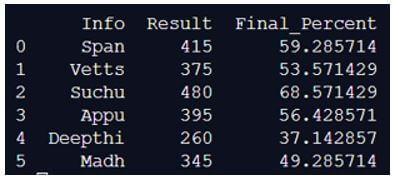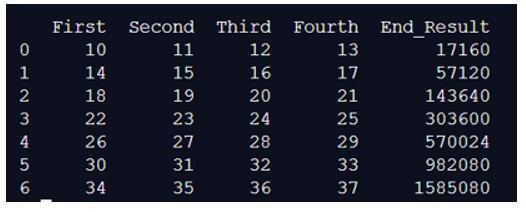Updated April 4, 2023
Introduction to Pandas Lambda
Pandas Lambda function is a little capacity containing a solitary articulation. Lambda capacities can likewise go about as unknown capacities where they do not need any name. These are useful when we need to perform little undertakings with less code. Lambda functions offer a double lift to an information researcher. You can compose tidier Python code and accelerate your AI undertakings. The stunt lies in acing lambda capacities, and this is the place where tenderfoots can entangle. We can likewise utilize lambda capacities when we need to pass a little capacity to another capacity. Lambda capacities are convenient and utilized in many programming dialects, yet we will be zeroing in on utilizing them in Python here.
Syntax and Parameters:
Lambda x:xWhere,
- Lambda represents the keyword of the function.
- First, x represents the bound variable.
- The second x represents the body of the function that has to be implemented.
- The watchword is compulsory, and it must be a lambda, while the contentions and body can change dependent on the necessities.
How does Lambda Function work in Pandas?
Given below shows examples of how lambda functions are implemented in Pandas.
Example #1
Utilizing Lambda function to a single column of the dataframe.
Code:
import pandas as pd
info= [['Span',415],['Vetts',375],['Suchu',480],
['Appu',395],['Deepthi',260],['Madh',345]]
dataframe = pd.DataFrame(info,columns=['Info','Result'])
dataframe = dataframe.assign(Final_Percent = lambda y: (y['Result'] /700 * 100))
print(dataframe.assign(Final_Percent = lambda y: (y['Result'] /700 * 100)))Output:
In the above program, we first import the Pandas library as pd and then define the dataframe. After defining the dataframe, we assign the values and then use the lambda function and dataframe.assign to assign the equation of this function in order to implement it. Thus, the program is implemented, and the output is as shown in the above snapshot.
Example #2
Utilizing Lambda function to multiple columns of the Pandas dataframe.
Code:
import pandas as pd
info = [[10,11,12,13], [14,15,16,17], [18,19,20,21],
[22,23,24,25], [26,27,28,29], [30,31,32,33],
[34,35,36,37]]
dataframe = pd.DataFrame(info, columns=['First', 'Second', 'Third', 'Fourth'])
dataframe = dataframe.assign(End_Result=lambda y: (y['First'] * y['Second'] * y['Third'] * y['Fourth']))
print(dataframe.assign(End_Result=lambda y: (y['First'] * y['Second'] * y['Third'] * y['Fourth'])))Output:
In the above program, we, as seen previously, import the pandas’ library as pd and then define the dataframe, which consists of multiple columns. Then we assign values to these columns of the dataframe and use the lambda function to give us the final result by using the equation as shown in the program. Hence, the program is implemented, and the output is as shown in the above snapshot.
We can utilize the apply() capacity to apply the lambda capacity to the two lines and segments of a dataframe. On the off chance that the hub contention in the apply() work is 0, at that point, the lambda work gets applied to every segment, and in the event that 1, at that point, the capacity gets applied to each column.
The channel() work takes a lambda work and a Pandas arrangement and applies for the lambda work on the arrangement and channels the information. This profits a grouping of True and False, which we use for sifting the information. Hence, the info size of the guide() work is consistently more noteworthy than the yield size. This guide() work maps the arrangement as per input correspondence. It is useful when we need to substitute an arrangement with different qualities. In map() works, the size of the info is equivalent to the size of the yield.
Lambda works likewise uphold restrictive proclamations, for example, if. Else. This makes lambda works amazing. Lambda capacities are very helpful when you are working with a great deal of iterative code. Reduce () work applies the lambda capacity to the initial two components of the arrangement and returns the outcome. At that point, it stores that outcome and again applies a similar lambda capacity to the outcome and the following component in the arrangement. Consequently, it diminishes the arrangement to a solitary worth. Lambda works in reduce() cannot take multiple contentions.
In Pandas, we have the opportunity to add various capacities at whatever point required, like lambda work, sort work, and so on. We can apply a lambda capacity to both the sections and lines of the Pandas information outline.
Conclusion
Hence we would like to conclude by stating that lambda functions are characterized utilizing the watchword lambda. They can have quite a few contentions yet just a single articulation. A lambda work cannot contain any assertions, and it restores a capacity object which can be appointed to any factor. They are commonly utilized for one-line articulations. Ordinary capacities are made utilizing the def watchword. They can have quite a few contentions and quite a few articulations. They can contain any assertions and are commonly utilized for huge squares of code.
Recommended Articles
We hope that this EDUCBA information on “Pandas Lambda” was beneficial to you. You can view EDUCBA’s recommended articles for more information.




